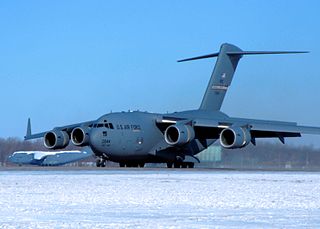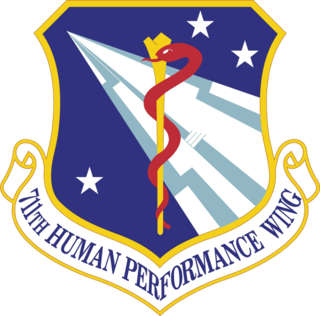
Wright-Patterson Air Force Base (WPAFB) is a United States Air Force base and census-designated place just east of Dayton, Ohio, in Greene and Montgomery counties. It includes both Wright and Patterson Fields, which were originally Wilbur Wright Field and Fairfield Aviation General Supply Depot. Patterson Field is approximately 16 kilometres (10 mi) northeast of Dayton; Wright Field is approximately 8.0 kilometres (5 mi) northeast of Dayton.

IDEF, initially an abbreviation of ICAM Definition and renamed in 1999 as Integration Definition, is a family of modeling languages in the field of systems and software engineering. They cover a wide range of uses from functional modeling to data, simulation, object-oriented analysis and design, and knowledge acquisition. These definition languages were developed under funding from U.S. Air Force and, although still most commonly used by them and other military and United States Department of Defense (DoD) agencies, are in the public domain.

The Air Force Research Laboratory (AFRL) is a scientific research organization operated by the United States Air Force Materiel Command dedicated to leading the discovery, development, and integration of aerospace warfighting technologies, planning and executing the Air Force science and technology program, and providing warfighting capabilities to United States air, space, and cyberspace forces. It controls the entire Air Force science and technology research budget which was $2.4 billion in 2006.

Air Force Materiel Command (AFMC) is a major command (MAJCOM) of the United States Air Force (USAF). AFMC was created on July 1, 1992, through the amalgamation of the former Air Force Logistics Command (AFLC) and the former Air Force Systems Command (AFSC).

Integrated Computer-Aided Manufacturing (ICAM) is a US Air Force program that develops tools, techniques, and processes to support manufacturing integration. It influenced the computer-integrated manufacturing (CIM) and computer-aided manufacturing (CAM) project efforts of many companies. The ICAM program was founded in 1976 and initiative managed by the US Air Force at Wright-Patterson as a part of their technology modernization efforts. The program initiated the development a series of standards for modeling and analysis in management and business improvement, called Integrated Definitions, short IDEFs.
A functional software architecture (FSA) is an architectural model that identifies enterprise functions, interactions and corresponding IT needs. These functions can be used as a reference by different domain experts to develop IT-systems as part of a co-operative information-driven enterprise. In this way, both software engineers and enterprise architects can create an information-driven, integrated organizational environment.

An information model in software engineering is a representation of concepts and the relationships, constraints, rules, and operations to specify data semantics for a chosen domain of discourse. Typically it specifies relations between kinds of things, but may also include relations with individual things. It can provide sharable, stable, and organized structure of information requirements or knowledge for the domain context.

IDEF0, a compound acronym, is a function modeling methodology for describing manufacturing functions, which offers a functional modeling language for the analysis, development, reengineering and integration of information systems, business processes or software engineering analysis.

Integration DEFinition for information modeling (IDEF1X) is a data modeling language for the development of semantic data models. IDEF1X is used to produce a graphical information model which represents the structure and semantics of information within an environment or system.
Douglas Taylor "Doug" Ross was an American computer scientist pioneer, and chairman of SofTech, Inc. He is most famous for originating the term CAD for computer-aided design, and is considered to be the father of Automatically Programmed Tools (APT), a programming language to drive numerical control in manufacturing. His later work focused on a pseudophilosophy he developed and named Plex.

The Aeronautical Systems Center (ASC) is an inactivated Air Force product center that designed, developed and delivered weapon systems and capabilities for U.S. Air Force, other U.S. military, allied and coalition-partner warfighters. ASC managed 420 Air Force, joint and international aircraft acquisition programs and related projects; executed an annual budget of $19 billion and employed a workforce of more than 11,000 people located at Wright-Patterson Air Force base and 38 other locations worldwide. ASC's portfolio included capabilities in fighter/attack, long-range strike, reconnaissance, mobility, agile combat support, special operations forces, training, unmanned aircraft systems, human systems integration and installation support. ASC was deactivated during a July 20, 2012 ceremony held at Wright-Patterson Air Force Base, Ohio.

The 711th Human Performance Wing is a wing of the United States Air Force based at Wright-Patterson Air Force Base near Dayton, Ohio.

In systems engineering, software engineering, and computer science, a function model or functional model is a structured representation of the functions within the modeled system or subject area.
Enterprise engineering is the body of knowledge, principles, and practices used to design all or part of an enterprise. An enterprise is a complex socio-technical system that comprises people, information, and technology that interact with each other and their environment in support of a common mission. One definition is: "an enterprise life-cycle oriented discipline for the identification, design, and implementation of enterprises and their continuous evolution", supported by enterprise modelling. The discipline examines each aspect of the enterprise, including business processes, information flows, material flows, and organizational structure. Enterprise engineering may focus on the design of the enterprise as a whole, or on the design and integration of certain business components.

IDEF3 or Integrated DEFinition for Process Description Capture Method is a business process modelling method complementary to IDEF0. The IDEF3 method is a scenario-driven process flow description capture method intended to capture the knowledge about how a particular system works.

IDEF4, or Integrated DEFinition for Object-Oriented Design, is an object-oriented design modeling language for the design of component-based client/server systems. It has been designed to support smooth transition from the application domain and requirements analysis models to the design and to actual source code generation. It specifies design objects with sufficient detail to enable source code generation.

Siva Subrahmanyam Banda is an Indian-American aerospace engineer. He is Director of the Control Science Center of Excellence and Chief Scientist for the Aerospace Systems Directorate at the United States Air Force Research Laboratory at Wright-Patterson Air Force Base. He has taught at Wright State University, the University of Dayton, and the Air Force Institute of Technology.

Method engineering in the "field of information systems is the discipline to construct new methods from existing methods". It focuses on "the design, construction and evaluation of methods, techniques and support tools for information systems development".

IDEF6 or Integrated Definition for Design Rationale Capture is a method to facilitate the acquisition, representation, and manipulation of the design rationale used in the development of enterprise systems. This method, that wants to define the motives that drive the decision-making process, is still in development. Rationale is the reason, justification, underlying motivation, or excuse that moved the designer to select a particular strategy or design feature. More simply, rationale is interpreted as the answer to the question, “Why is this design being done in this manner?” Most design methods focus on what the design is.

John Ferdinand "JT" Thompson is a retired lieutenant general in the United States Air Force who last served as the commander of the Space and Missile Systems Center from May 2017 to July 2021. He entered the United States Air Force in 1984 as a graduate of the United States Air Force Academy.















